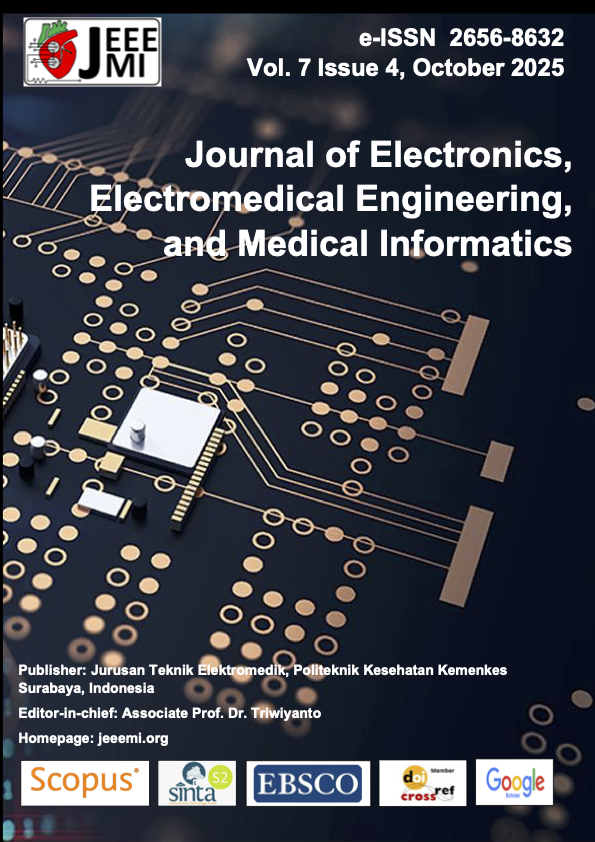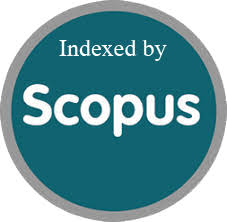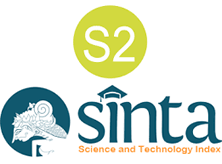COV-TViT: An Improved Diagnostic System for COVID Pneumonitis Utilizing Transfer Learning and Vision Transformer on X-Ray Images
Abstract
COVID is a contagious lung ailment that continues to be a world curse, and it remains a highly infectious respiratory disease with global health implications. Traditional diagnostic methods, such as RT-PCR, though widely used, are often constrained by high costs, limited accessibility, and delayed results. In contrast, radiology for lung disease detection has been proven advantageous for identifying deformities, and chest X-rays are the most preferred radiological method due to their non-invasive nature. To address these limitations, this study aims to develop an efficient, automated diagnostic system leveraging radiological imaging, specifically X-rays, which are cost-effective and widely available. The primary contribution of this research is the introduction of COV-TViT, a novel deep learning framework that integrates transfer learning with Vision Transformer (ViT) architecture for the accurate detection of COVID pneumonitis. The proposed method is evaluated using the COVID-QU-Ex dataset, which comprises a balanced set of X-ray images from COVID positive and healthy individuals. Methodologically, the system employs pre-trained convolutional neural networks (CNNs), specifically VGG16 and VGG19 (Visual Geometry Group), for transfer learning, followed by fine tuning to enhance feature extraction. The ViT model, known for its self-attention mechanism, is then applied to capture complex spatial dependencies in the X-ray images, enabling robust classification. Experimental results demonstrate that COV-TViT achieves a classification accuracy of 98.96% and an F1 score of 96.21%, outperforming traditional CNN based transfer learning models in several scenarios. These findings underscore the model’s potential for high-precision COVID pneumonitis detection. The proposed approach significantly transforms classification tasks using self-attention mechanisms to extract features and learn representations. Overall, the proposed diagnostic system COV-TViT can be advantageous in the fundamental identification of COVID pneumonitis.
Downloads
References
WHO Director-General’s opening remarks at the media briefing on COVID-19, 11 March 2020. [Online]. Available: https://www.who.int/director-general/speeches/detail/who-director-general-s-opening-remarks-at-the-media-briefing-on-covid-19---11-march-2020 [Accessed: Jun. 1, 2025].
A. F. Versiani, L. M. Andrade, T. F. S. Moraes, E. M. N. Martins, F. F. Bagno, L. a. F. Andrade, et al., “Serologic LSPR-nanosensor against SARS-COV-2 antibodies and related variants outperforms ELISA in sensitivity,” npj Biosensing, nature, Vol.2, 11, 2025, doi: 10.1038/s44328-025-00029-y
V. Newton, O. Farinu, H. Smith, M. I. Jackson, and S. D. Martin, “Speaking out: Factors influencing Black Americans’ engagement in COVID-19 testing and research,” Journal of Racial and Ethnic Health Disparities, Jan. 2025, doi: 10.1007/s40615-024-02268-7.
V. Septa, P. Ray, B. Mondal, V. Shitole, and P. Kumar, “BioSampler device for collection and storage of RNA samples to diagnose SARS-COV-2,” Deleted Journal, May 2025, doi: 10.1007/s44174-025-00353-x.
C. Wertenauer, A. Dressel, E. Wieland et al., “Diagnostic performance of rapid antigen testing for SARS-CoV-2: the COVID-19 AntiGen (COVAG) extension study,” Front. Med., vol. 11, 2024, doi:10.3389/fmed.2024.1352635.
J. A. R. Amat, S. N. Dudgeon, N. R. Cheemarla, T. A. Watkins, A. B. Green, H. P. Young, et al., “Nasal biomarker testing to rule out viral respiratory infection and triage samples: a test performance study,” EBioMedicine, vol. 117, p. 105820, Jun. 2025, doi: 10.1016/j.ebiom.2025.105820.
E. M. F. E. Houby, “COVID-19 detection from chest X-ray images using transfer learning,” Sci. Rep., vol. 14, 2024, doi:10.1038/s41598-024-61693-0.
S. Minaee, R. Kafieh, M. Sonka, S. Yazdani, and G. J. Soufi, “Deep-COVID: Predicting COVID-19 from chest X-ray images using deep transfer learning,” Med. Image Anal., vol. 65, art. 101794, 2020, doi: 10.1016/j.media.2020.101794.
L. Wang, Z. Q. Lin, and A. Wong, “COVID-Net: a tailored deep convolutional neural network design for detection of COVID-19 cases from chest X-ray images,” Sci. Rep., vol. 10, 2020, doi:10.1038/s41598-020-76550-z.
V. Kumawat, B. Umamaheswari, P. Mitra, and G. Lavania, “Machine Learning for Health Care: Challenges, Controversies, and Its Applications,” in Lecture Notes in Networks and Systems, 2022, pp. 253–261, doi:10.1007/978-981-19-0707-4_24.
S. Park, “Vision Transformer for COVID-19 CXR Diagnosis using Chest X-ray Feature Corpus,” arXiv preprint arXiv:2103.07055, 2021.
M. T. Anas, M. E. H. Chowdhury, Y. Qiblawey, A. Khandakar, T. Rahman, S. Kiranyaz et al., “COVID-QU-Ex,” Kaggle, 2021, doi: https://doi.org/10.34740/kaggle/dsv/3122958.
K. Simonyan and A. Zisserman, “Very deep convolutional networks for large-scale image recognition,” arXiv preprint arXiv:1409.1556, 2014.
C. C. Ukwuoma, Z. Qin, M. B. B. Heyat et al., “Automated Lung-Related Pneumonia and COVID-19 Detection Based on Novel Feature Extraction Framework and Vision Transformer Approaches Using Chest X-ray Images,” Bioengineering, vol. 9, art. 709, 2022, doi:10.3390/bioengineering9110709.
E. Hussain, M. Hasan, M. A. Rahman, I. Lee, T. Tamanna, and M. Z. Parvez, “CoroDet: A deep learning based classification for COVID-19 detection using chest X-ray images,” Chaos Solitons Fractals, vol. 142, art. 110495, 2021, doi: 10.1016/j.chaos.2020.110495.
A. Narin, C. Kaya, and Z. Pamuk, “Automatic detection of coronavirus disease (COVID-19) using X-ray images and deep convolutional neural networks,” Pattern Anal. Appl., vol. 24, pp. 1207–1220, 2021, doi:10.1007/s10044-021-00984-y.
T. Rahman, A. Khandakar, Y. Qiblawey et al., “Exploring the effect of image enhancement techniques on COVID-19 detection using chest X-ray images,” Comput. Biol. Med., vol. 132, art. 104319, 2021, doi: 10.1016/j.compbiomed.2021.104319.
A. I. Khan, J. L. Shah, and M. M. Bhat, “CoroNet: A deep neural network for detection and diagnosis of COVID-19 from chest x-ray images,” Comput. Methods Programs Biomed., vol. 196, art. 105581, 2020, doi: 10.1016/j.cmpb.2020.105581.
M. Fu, C. Tantithamthavorn, and T. Le, “DAViT: A domain-adapted vision transformer for automated pneumonia detection and explanation using chest X-ray images,” IEEE Access, p. 1, Jan. 2025, doi: 10.1109/access.2025.3579314.
M. M. Rahaman, C. Li, Y. Yao et al., “Identification of COVID-19 samples from chest X-Ray images using deep learning: A comparison of transfer learning approaches,” J. X-ray Sci. Technol., vol. 28, pp. 821–839, 2020, doi:10.3233/xst-200715.
J. P. Cohen, P. L. Morrison, and L. Dao, “COVID-19 image data collection,” arXiv preprint arXiv:2003.11597, 2020.
Chest X-Ray Images (Pneumonia). Kaggle. [Online]. Available: https://www.kaggle.com/datasets/paultimothymooney/chest-xray-pneumonia [Accessed: Jun. 4, 2025].
C. R. Kishore, R. Pemula, S. V. Kumar, K. P. Rao, and S. C. Sekhar, “Deep Learning Models for Identification of COVID-19 Using CT Images,” in Lecture Notes in Networks and Systems, 2022, pp. 577–588, doi:10.1007/978-981-19-0707-4_52.
I. M. Mohammed and N. A. M. Isa, “Contrast limited Adaptive local histogram equalization method for poor contrast image enhancement,” IEEE Access, p. 1, Jan. 2025, doi: 10.1109/access.2025.3558506.
S. Kumar and H. Kumar, “Classification of COVID-19 X-ray images using transfer learning with visual geometrical groups and novel sequential convolutional neural networks,” MethodsX, vol. 11, art. 102295, 2023, doi: 10.1016/j.mex.2023.102295.
T. Garg, M. Garg, O. P. Mahela, and A. R. Garg, “Convolutional Neural Networks with Transfer Learning for Recognition of COVID-19: A Comparative Study of Different Approaches,” AI, vol. 1, pp. 586–606, 2020, doi:10.3390/ai1040034.
D. Sharifrazi, R. Alizadehsani, M. Roshanzamir et al., “Fusion of convolution neural network, support vector machine and Sobel filter for accurate detection of COVID-19 patients using X-ray images,” Biomed. Signal Process. Control, vol. 68, art. 102622, 2021, doi: 10.1016/j.bspc.2021.102622.
E. F. Ohata, G. M. Bezerra, J. V. S. D. Chagas et al., “Automatic detection of COVID-19 infection using chest X-ray images through transfer learning,” IEEE/CAA J. Autom. Sin., vol. 8, pp. 239–248, 2021, doi:10.1109/JAS.2020.1003393.
K. S. Jones, “Natural Language Processing: A Historical review,” Springer eBooks, pp. 3–16, Jan. 1994, doi: 10.1007/978-0-585-35958-8_1.
G. Tian, Z. Wang, C. Wang et al., “A deep ensemble learning-based automated detection of COVID-19 using lung CT images and Vision Transformer and ConvNeXt,” Front. Microbiol., vol. 13, 2022, doi:10.3389/fmicb.2022.1024104.
D. Shome, T. Kar, S. Mohanty et al., “COVID-Transformer: Interpretable COVID-19 Detection Using Vision Transformer for Healthcare,” Int. J. Environ. Res. Public Health, vol. 18, art. 11086, 2021, doi:10.3390/ijerph182111086.
H. Ç. Zaim and E. N. Yolaçan, “FPE–Transformer: a feature positional Encoding-Based transformer model for attack detection,” Applied Sciences, vol. 15, no. 3, p. 1252, Jan. 2025, doi: 10.3390/app15031252.
T. Chen, I. Philippi, Q. B. Phan et al., “A vision transformer machine learning model for COVID-19 diagnosis using chest X-ray images,” Healthc. Anal., vol. 5, art. 100332, 2024, doi: 10.1016/j.health.2024.100332.
S. Kadry, L. Abualigah, R. G. Crespo et al., “COVID-19 detection in chest X-ray using vision-transformer with different patch dimensions,” Procedia Comput. Sci., vol. 235, pp. 3438–3446, 2024, doi: 10.1016/j.procs.2024.04.324.
M. R. Naidji and Z. Elberrichi, “A novel hybrid vision transformer CNN for COVID-19 detection from ECG images,” Computers, vol. 13, art. 109, 2024, doi:10.3390/computers13050109.
S. Kumar, H. Kumar, G. Kumar, S. P. Singh, A. Bijalwan, and M. Diwakar, “A methodical exploration of imaging modalities from dataset to detection through machine learning paradigms in prominent lung disease diagnosis: a review,” BMC Med. Imaging, vol. 24, 2024, doi:10.1186/s12880-024-01192-w.
S. Kumar and H. Kumar, “Efficient-VGG16: A novel ensemble method for the classification of COVID-19 X-ray images in contrast to machine and transfer learning,” Procedia Comput. Sci., vol. 235, pp. 1289–1299, 2024, doi: 10.1016/j.procs.2024.04.122.
G. Gössler, V. Hofer, and W. Goessler, “Evaluation of four different standard addition approaches with respect to trueness and precision,” Analytical and Bioanalytical Chemistry, Jan. 2025, doi: 10.1007/s00216-024-05725-8.
M. H. Temel, Y. Erden, and F. Bağcıer, “Evaluating artificial intelligence performance in medical image analysis: Sensitivity, specificity, accuracy, and precision of ChatGPT-4o on Kellgren-Lawrence grading of knee X-ray radiographs,” The Knee, vol. 55, pp. 79–84, Apr. 2025, doi: 10.1016/j.knee.2025.04.008.
S. Kumar and H. Kumar, “LungCov: A diagnostic framework using machine learning and imaging modality,” Int. J. Tech. Phys. Prob. Eng., vol. 51, pp. 190–199, 2022. [Online]. Available: https://www.iotpe.com/IJTPE/IJTPE-2022/IJTPE-Issue51-Vol14-No2-Jun2022/23-IJTPE-Issue51-Vol14-No2-Jun2022-pp190-199.pdf
R. Rajpoot, S. Jain, V. B. Semwal, and D. Singh, “Quantitative Assessment of XAI Methods for COVID-19 Detection: A Comparative approach,” SN Computer Science, vol. 6, no. 2, Jan. 2025, doi: 10.1007/s42979-025-03663-5.
T. Melvin, “The European Medical Device Regulation - What Biomedical Engineers Need to Know,” IEEE J. Transl. Eng. Health Med., vol. 10, 4800105, Jul. 2022, doi: 10.1109/JTEHM.2022.3194415.
G. Boyle, T. Melvin, R. M. Verdaasdonk et al., “Hospitals as medical device manufacturers: keeping to the Medical Device Regulation (MDR) in the EU,” BMJ Innov., vol. 10, pp. 74–80, 2024.
N. Khehrah, M. S. Farid, S. Bilal, and M. H. Khan, “Lung nodule detection in CT images using statistical and shape-based features,” J. Imaging, vol. 6, no. 2, p. 6, 2020, doi: 10.3390/jimaging6020006.
C. N. Villavicencio et al., “Development of a machine learning based web application for early diagnosis of COVID-19 based on symptoms,” Diagnostics, vol. 12, no. 4, p. 821, Mar. 2022, doi: 10.3390/diagnostics12040821.
M. Gheisari et al., “Mobile apps for COVID-19 detection and diagnosis for future pandemic control: multidimensional systematic review,” JMIR Mhealth Uhealth, vol. 12, e44406, Feb. 2024, doi: 10.2196/44406.
Copyright (c) 2025 Sunil Kumar, Amar Pal Yadav, Neha Nandal, Vishal Awasthi, Luxmi Sapra, Prachi Chhabra

This work is licensed under a Creative Commons Attribution-ShareAlike 4.0 International License.
Authors who publish with this journal agree to the following terms:
- Authors retain copyright and grant the journal right of first publication with the work simultaneously licensed under a Creative Commons Attribution-ShareAlikel 4.0 International (CC BY-SA 4.0) that allows others to share the work with an acknowledgement of the work's authorship and initial publication in this journal.
- Authors are able to enter into separate, additional contractual arrangements for the non-exclusive distribution of the journal's published version of the work (e.g., post it to an institutional repository or publish it in a book), with an acknowledgement of its initial publication in this journal.
- Authors are permitted and encouraged to post their work online (e.g., in institutional repositories or on their website) prior to and during the submission process, as it can lead to productive exchanges, as well as earlier and greater citation of published work (See The Effect of Open Access).





.png)
.png)
.png)
.png)
.png)
